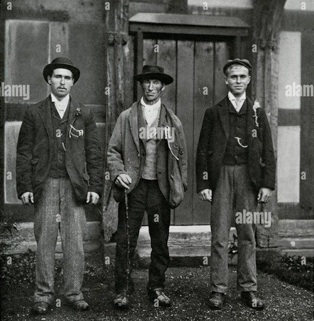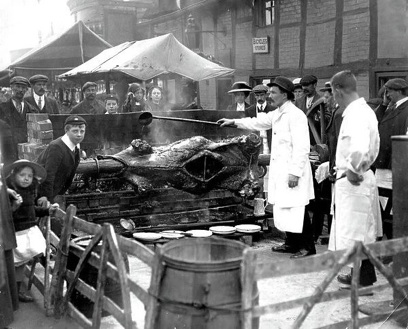More Modern Times

SLHS Mop Fair



Disclaimer
Whilst some care has been taken to check externally linked websites no responsibility is offered nor implied for the suitability, legality or reliability of content therein.
Statements are made here to the best of our knowledge. However no statement here should be regarded as irrefutable fact. Please contact us if you consider otherwise.
History
Carried by fleas the Black Death, aka The Plague pandemic, had ravaged Europe 1346-53 and is estimated to have killed 30-60% of the population. Workers everywhere were in acute short supply. During his reign Edward III (having been enthroned by John de Stratford in 1327) sought to mobilise as many able bodied adults as possible by outlawing the, at times, outright exploitation of lowly workers by ensuring fair wages for them throughout England. To this end in 1351 he enacted the Statute Of Labourers. The struggle continued and so twelve years later his Statue Of Apprentices set out minimum wages and conditions of employment. As most of these people were illiterate how were they to make prospective employers aware of their existence ?
As they do now fairs travelled throughout the land offering entertainment, competitions and, above all, some form of feasting. Edward had set out that a specific day was to be set aside annually in which people could be released from their bond of employment and seek work elsewhere. They would carry a sign of their trade: a shovel, a hammer, a scythe or even a humble mop on a stick.
Reasonable accommodation was to be offered. Some employers were good and some were unfair and if the worker didn’t like their new job then two weeks later a second fair was to be held and they were given the chance to run away. If they chose to stay then they received a down-payment of sixpence. Rather cruelly often that the worker wasn’t then paid until the end of their year ! (Note that the Romans had been paid in coinage and annually in salt -hence the payment was known as a salary).
Hopefully there were only a few who chose to try again. The second fair was smaller and therefore became known as the Runaway Mop. Let’s look at some articles..
Further Information..
-
Local fairs in Warwickshire & Worcestershire: World’sFair-Funfairs If you’re interested in significantly more information do click the Funfairs tab for 28 pages of detailed information.
-
Steam Rallies: SteamHeritage: UK Diary
Throughout Stratford Town Centre
● These items have aspects that uniquely contribute to national or world history.



Accompanying this Alamy article is the picture (right).
'Standing for Hire', Stratford-upon-Avon, said to be the largest fair in England, regarded by the agricultural class in the district as the chief holiday of the year. Annually in October, farm workers, labourers and servants, would attend the Mop Fair dressed in their Sunday best clothes and carrying an item signifying their trade in their buttonhole. Grooms carry a bit of straw, shepherds a twist of wool, carters a length of whipcord and servants with no particular skills would carry a mop head - hence the phrase Mop Fair, the custom was general at hiring fair. Date: 1899
Modern Businesses Need A Mop
We may consider the idea of a mop fair quaint or even an anachronism. However it hasn’t been long since there was a modern day pandemic. Of course the hotel and restaurant trades suffered great losses financially and to their staff numbers. In 2021 a 650 year old custom was resurrected as part of a modern day recruitment drive (see picture right)
From Guardian article.


Accompanying this Printsonline article is the picture (left).
Scene showing an ox being roasted at the Stratford-upon-Avon annual Mop Fair, Warwickshire. Farm workers, labourers, servants and some craftsmen would work for their employer from October to October. At the end of the employment they would attend the Mop Fair dressed in their Sunday best clothes and carrying an item signifying their trade. A servant with no particular skills would carry a mop head hence the term Mop Fair.
Employers would move amongst them discussing experience and terms, and once agreement was reached the employer would give the employee a small token of money and the employee would wear bright ribbons to indicate that they had been hired.
The stalls at the fair sold food and drink, while others offered games to play. Date 1911.

Modern Funfairs
Outside of the permanent fixtures in towns like Blackpool, Great Yarmouth, Southend etc to this day there are around 80 towns who give over their streets to an annual temporary traveling fun fair. Not all are Mop Fairs. The large ones have to be held in specially assigned spaces not least because of the significant issues regarding clean water supply and waste & sewage disposal.
Currently the largest fair in geographic layout is The Great Dorset Steam Fair which covers 600 acres and claims the largest collection of steam and vintage equipment to be seen anywhere in the world. Held at the beginning of September numbers used to be 350,000 but annually there are now around 200,000 visitors.
Started 1284 the oldest large fair by numbers is the Nottingham Goose Fair which attracts around 400,000 visitors. Other large ones are at Bridgwater and Tewkesbury. The latter takes place just days before Stratford’s.
Another giant fair is Hoppings in Newcastle’s Town Moor ground. It boasts 400 reasonably priced rides but oddly in the middle of June when children are still at school.

It’s All Over For Another Year
Having grafted for the town’s entertainment this section of Bob Wilson’s Funfair sets off north on Guild Street to join the Birmingham Road in 1959.
However this photo is quite informative because not only does it show that there are no traffic lights here the old brewery (left) is in fairly good condition.
And if you look in the middle distance that’s not the Holy Trinity Church but you can see the now removed St James Church which was replaced by flats.
Hover over for enlargement.
To return to Master page click on ‘Markets & Fairs’ above.


The Shufflebottoms were a knife throwing act that always performed near the URC Church
-
● Full
-
● Partial
-
● None
-
Theatres ●
Last update: 31/10/2024
Created: 18/02/2024
